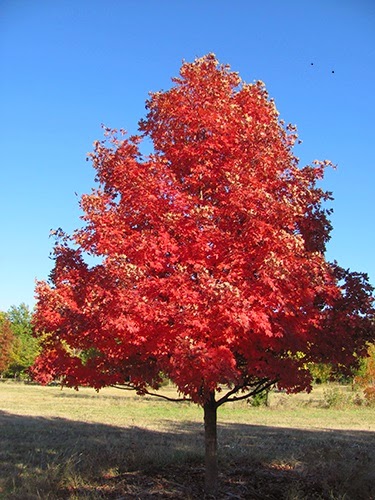Caddo Sugar Maples – Possible Solution to High Soil pH Problems
Jenae Ryan, Horticulture Agent
Sugar maples often have significant problems growing well in our Kansas weather. The hot, often dry summers and windy conditions can shorten the life of these trees. High pH soils, such as those found in the Post Rock District, frequently cause iron chlorosis in maple trees. However, some sugar maples are better adapted to Kansas conditions than others.
Kansas State University’s John C. Pair Horticulture Center has evaluated sugar maples for more than 20 years and has identified selections that are much better adapted to Kansas. Of particular interest are the Caddo sugar maples, which originated from an isolated population in Caddo County, Oklahoma. These are true sugar maples and are considered an ecotype. Caddo sugar maples are more drought tolerant, better adapted to high pH soils, and more resistant to leaf scorch and tatter than the normal sugar maples.
Data from the research center shows just how impressive the resistance to scorch is in the Caddo sugar maples. The last three weeks of August in 2003 saw temperatures at the research station reach over 100 degrees each day with no rain for the month prior. All other sugar maples in the trial had severely scorched leaves. Not a single leaf of any of the caddo maples was scorched. Leaf water potential readings taken pre-dawn showed all other trees in the trial past the wilting point while the Caddo maples were barely stressed.
Another interesting characteristic of Caddo maples is that they tend to retain their leaves in the winter and therefore have been suggested as screens or for use in windbreaks.
Dr. John Pair, the late director of the Horticulture Center, selected and released two Caddo maples over 10 years ago. Both these selections color early and have consistent good red fall color. Drought tolerance and resistance to leaf scorch and leaf tatter are exceptional. However, neither will do well in a heavy clay soil that is frequently saturated. These trees can be damaged or killed if planted in wet sites.
The first variety, ‘Autumn Splendor’, has the traditional sugar maple growth pattern and needs plenty of room to mature. The ‘John Pair’ variety is smaller, more compact, and more likely to fit a residential landscape. This tree is also noted for a dense, uniform crown.
If you have had trouble successfully growing maple trees in our high pH soils and are in the market for a new tree, consider the Caddo sugar maple. For other trees adapted to the climate in the Post Rock District, check out the “Selected Trees and Shrubs for Northwest Kansas Landscapes” publication: http://bit.ly/1JPdtyQ.








